|
1.
CENTRAL AND WEST AFRICA
Weakening demand in international markets
Operators across the regional have signalled a significant
weakening of demand in international markets. Some mills
servicing the Chinese market have temporarily ceased
operations due to falling Chinese timber imports, others,
have pivoted production to species in demand in the EU
notably azobe for the Dutch market and timbers such as
padouk for Belgium, agba for Portugal and bahia for Italy.
The overall sentiment is that business remains poor,
exacerbated by the European holiday season.
The correspondent writes “the market for West/Central
African timbers is currently in a precarious state with
many mills struggling to stay operational amid
plummeting demand. The situation is exacerbated by
adverse weather conditions in some regions and regulatory
pressures in others. Operators in the region are hoping for
additional economic stimulus measures in China. At
present it is only the Philippines and Vietnam that are
providing a measure of demand stability”.
Regional round-up
Cameroon
Mills are focusing on redwood species for Europe.
However, it has been reported that arrivals of redwoods
from North Congo and RCA at Douala and Kribi Ports
have dropped. Millers have observed a rise in regulatory
control which has made some mills keeping stocks to a
minimum.
Equatorial Guinea
It has been claimed that some shippers in Equatorial
Guinea are putting KD FAS okoume onto the international
market at around Eur400/cu.m. FOB which a very
competitive price. The correspondent notes “In Gabon and
Congo it is impossible to compete with the Eur400/cu.m.
FOB price due to the high operational costs faced by mills
and the long-distance transport involved.
Gabon
Harvesting remains slow as demand is low for some
species. Okoume continues to be in demand for local
manufacturing but okoume exports to China have stopped.
Electricity disruptions continue to disturb peeling and
plywood operations, particularly in the GSEZ.
No transport issues have been reported but the Bifoun to
Ndjole road, the main route for trucking in and out of
Cameroon, is reportedly in poor condition and repairs will
take several weeks.
Enquiry levels are stable for species such as andoung,
iroko, and padouk in Europe. For the Chinese market
current demand is focused on high-value timbers such as
beli and ovangkol.
Congo
In terms of harvesting and trucking there are no changes
from the mid-July report. Repairs continue on laterite
roads which were damaged during the rain season.
Trucking conditions are expected to improve now that it is
dry. Transport to Pointe Noire is mostly on tarmac roads.
Operators report enquiry levels are satisfactory especially
as importers for the Philippines market are more active.
New EUDR tools
The ATIBT has signalled that, as part of the
implementation of the EU Deforestation Regulation
(EUDR), the European Commission has developed two
additional applications for the Application Programming
Interface (API).
See: https://www.atibt.org/en/news/13527/implementation-of-
the-eudr-new-api-applications-for-due-diligence-declarations

Through the eyes of industry
The latest GTI report lists the challenges identified by the
private sector in the Republic of Congo and Gabon.
See, GGSC
https://www.itto-
ggsc.org/static/upload/file/20240719/1721354559472477.pdf
2.
GHANA
GDP target at 3.1% in mid-year budget
The Government has announced revisions to the country’s
macroeconomic fiscal targets for 2024. The Finance
Minister, Mohamed Amin Adam, said this when he
presented the mid-year Budget to parliament on July 23,
2024.
Dr. Amin Adam said the overall real Gross Domestic
Product (GDP) growth rate has been revised upwards from
2.8% to 3.1%. While he also stated that government has
decided to maintain the end of year inflation target
unchanged at 15%. He further said, non-oil real GDP
growth rate was also revised upwards from 2.% to 2.8%.
The Minister lauded government’s fiscal discipline in the
first half of 2024 stating that government expenditure
amounted to GH¢95.9 billion, below the budget target of
GH¢104.8 billion. He also reported significant progress in
fulfilling the government’s financial obligations to
investors following the completion of the Domestic Debt
Exchange Programme (DDEP) in September 2023.
Fitch Solutions has maintained its 2024 growth rate
forecast for Ghana at 4.3%, higher than the mid-year
budget revision of 3.1% and the International Monetary
Fund projection of 2.9%.
See: https://www.myjoyonline.com/government-revises-
economic-targets-upwards-for-2024/
Main markets account for almost 90% of exports
Three continental markets comprising Asia, Europe and
Africa are Ghana’s key wood export destinations and
together accounted for 89% (77,406 cu.m) of total wood
product export volumes in the first four months of 2024
(86,755 cu.m) as against 91% (89,661 cu.m) registered for
the same period in 2023 according to data from the Timber
Industry Development Division (TIDD).

Asia continued as Ghana’s top market destination earning
the country Eur21.33 million from the export of 54,738
cu.m during the period Jan-Apr 2024. This shows there
were declines of 9% in the value of exports and a 10%
drop in export volumes compared to the Eur23.51million
from exports of 60,971 cu.m in the Jan-Apr period of
2023. Exports of products to Asia included air and kiln-
dried sawnwood, teak logs, plywood, mouldings, billet and
sliced veneer. Key markets included India and Vietnam.
Europe accounted for 13,616 (16%) of the total wood
product export volume in the period under review with a
corresponding export value of Eur8.15 million. The
figures showed a decrease of 21% in value and a decrease
of 16% in volume when compared to the Eur10.37 million
from 16,194 cu.m recorded during Jan-Apr 2023.
The European market maintained its position as the most
attractive in terms of prices for sawnwood, plywood,
boules and briquettes. The main European countries that
traded with Ghana during the period were Germany,
Belgium, United Kingdom and Spain.
African country wood products imports from Ghana
included air and kiln dry sawnwood, plywood (by sea and
land to the regional markets) and rotary and sliced
veneers. These exports earned Ghana Eur3.83million from
the total volume of 9,052 cu.m shipped during the period
Jan.-Apr 2024.
Africa’s share of wood product exports were consumed
largely by ECOWAS countries that included Senegal,
Nigeria, Gambia, Burkina Faso, Sierra Leone and Togo.
The ECOWAS sub-region contributed Eur2.70 million
from 6,980 cu.m of the total African wood product
exports. Egypt, Morocco, Benin, South Africa and
Mozambique were the main Non-ECOWAS markets for
Ghana’s wood products.
The main species exported included teak, wawa,
eucalyptus, ceiba and denya among others.
Exports to the EU surged 8% in 2023
Ghana’s exports to the European Union (EU) increased by
8% in 2023 reaching Eur2.60 billion from Eur2.40 billion
in the previous year while imports from the EU to Ghana
fell from Eur3.70 billion in 2022 to Eur3.30 billion in
2023.
Speaking at the 2nd Ghana-EU Business Forum on the
theme ‘Fostering investment in non-traditional value
chains under the EU Global Gateway Strategy, the Trade
and Industry Minister highlighted the country’s favorable
investment climate.
Ghana’s export trade with the EU is primarily raw
materials and semi-processed goods. These include
sawnwood, plywood, mouldings, sliced and rotary veneers
and boules.
The EU Ambassador to Ghana, Irchad Razaaly, said the
Business Forum provided avenues of dialogue over
boosting trade and investment ties between Ghana and the
EU.
See: https://thebftonline.com/2024/07/05/ghana-eu-trade-dips/
IMF points to financial sector stability
The International Monetary Fund (IMF) has reported that
Ghana’s financial sector stability has been maintained
despite the Domestic Debt Exchange Programme (DDEP).
However, the IMF added credit growth declined amidst an
increase in non-performing loans.
In its Second Review of Ghana’s Extended Credit Facility
Programme the IMF statement said despite facing capital
shortfalls due to the implementation of the domestic debt
exchange (DDE), bank balance sheets improved quickly in
2023 benefiting from high profitability and capital
injections. The government of Ghana has begun the
recapitalisation of state-owned banks.
However, the growth in private sector credit was well
below inflation at 11.0% in 2023. In addition, the
nonperforming loans (NPLs) ratio further increased to
20.6% from 14.8% in December 2022.
See:
https://www.imf.org/en/News/Articles/2024/06/28/pr24241-
ghana-imf-exec-board-completes-2nd-rev-ecf-
arr#:~:text=The%20IMF%20Executive%20Board%20today,prog
ram%20has%20been%20generally%20strong.
and
https://www.myjoyonline.com/financial-sector-stability-
maintained-but-credit-growth-declines-imf/


3. MALAYSIA
Export growth recorded with major trading partners
The Ministry of Investment, Trade and Industry (MITI)
reported that in the first five months of 2024 exports
increased 1.7% year on year to RM126.05 billion while
imports rose 17.8% to RM111.76 billion. May marked the
50th consecutive month of surplus. Export growth was
contributed mainly by higher demand for machinery,
equipment and parts, liquefied natural gas (LNG) as well
as palm oil-based products. Export growth was recorded in
major trading partners; ASEAN, the US and Taiwan
P.o.C.
Sarawak/Japan MOU on forest ecosystem functions
The Sarawak government signed a memorandum of
understanding (MoU) with National University
Corporation Kyushu University (Kyushu-U) in Fukuoka,
Japan to facilitate bilateral collaboration and research on
forest ecosystem functions as part of forest assessments to
be carried out under forest carbon initiatives in Sarawak.
The MoU also aims to facilitate skills sharing through
capacity building, training for forestry officers and a
student exchange programme and other areas of mutually
agreed collaboration.
See: https://www.theborneopost.com/2024/07/24/sarawak-signs-
mou-with-japanese-university-in-connection-with-forest-carbon-
initiatives/
Sabah mangroves action plan
The Sabah State Government will launch a Sabah
Mangrove Action Plan to transform the management and
conservation of mangrove forests in Sabah according to
the Chief Minister, Haji Hajiji Haji Noor, who added 60%
or 378,195 hectares of Malaysia’s mangrove forests are in
Sabah.
Noor commented that this plan is consistent with the ‘Blue
Carbon initiative’, a global programme being coordinated
to focus on the conservation and preservation of the sea
shore ecosystem for climate adaption, biodiversity
protection and wealth generation for people living close to
mangrove forests.
See: https://www.theborneopost.com/2024/07/24/action-plan-to-
conserve-sabahs-mangrove-forests/
Smallholders and communities join planation plan
Sabah Forestry Department has distributed more than
37,000 seedlings to 81 smallholders who are registered
under the 12th Malaysia Plan element ‘Promote Tree
Planting by Smallholders and Local Communities as an
Important Source of Wood for the Timber Industry’.
The initiative primarily focuses on smallholders and local
communities with a land area of below 10 acres. A variety
of species, including Laran, Batai, Binuang, Eucalyptus,
Mahogany, Acacia, and Talisai Paya are being promoted.
Participants have benefited from consultations on forest
plantation practices. Chief conservator of forests Frederick
Kugan said this initiative demonstrates the Sabah Forestry
Department’s commitment and dedication to sustainable
forestry and community engagement.
See: https://www.theborneopost.com/2024/07/23/sabah-forestry-
distributes-over-37000-seedlings-to-81-smallholders/
Attracting investors to plant bamboo
A bamboo planting and smart farming project is set to be
implemented in Baram District according to the Sarawak
Timber Industry Development Corporation (STIDC).
Officials from STIDC and the Malaysian Community Care
Foundation (MCCF) recently visited the district to
encourage local communities to participate in the project.
One of the primary initiatives is to attract investors to
engage in bamboo planting, smart community farming and
ecotourism across the extensive 49,000 ha. Native
Customary Rights (NCR) land in the Baram area.
See:
https://theborneopost.pressreader.com/article/281762749494599
MTCC forest statistics
The Malaysian Timber Certification (MTCC) is an
independent organisation that develops and operates the
Malaysian Timber Certification Scheme (MTCS) which is
endorsed by PEFC.
As of June 2024, there were 6.73 million ha. of MTCS-
PEFC certified forests in 36 certified natural forest units
(FMUs) and nine certified forest plantations (FPMUs).
There were 362 companies holding MTCS-PEFC
certificates for Chain of Custody.
MTCC statistics show that in 2023 Japan maintained its
position as the leading importer of timber products
certified under MTCS, totaling 102,630 cu m. followed by
the Netherlands with United Kingdom, Australia, Belgium
and France among the top importers.
Total exports increased by 7.4 % from 244,946 cu m in
2022 to 264,240 cu m in 2023 with plywood, sawnwood
and mouldings remaining the major exported certified
products.
See: https://mtcc.com.my/
Through the eyes of industry
The latest GTI report lists the challenges identified by the
private sector in Malaysia.
See, GGSC
https://www.itto-
ggsc.org/static/upload/file/20240719/1721354559472477.pdf
4.
INDONESIA
Furniture imports flooding Indonesian market
The chairman of the Indonesian Furniture and Craft
Industry Association (HIMKI), Abdul Sobur, has pointed
out that the domestic market is being flooded with
imported furniture products. According to HIMKI’s
analysis in the first quarter of 2024 imports of furniture
products increased by 29% year on year to IDR2.07
trillion.
Imported furniture products from China contributed the
most (84%) followed by Vietnam (3%), Malaysia (2%)
and the US 2%.
Other significant shippers of mainly high value items
included Italy, Germany, Singapore, Taiwan P.o.C, South
Korea and Japan.
Sobur said Indonesians are buying simple and cheap smart
furniture and suggested the government should raise the
Domestic Source Component Level (TKDN) for furniture
products.
TKDN represents the value of using goods or services
sourced from within the country. This policy aims to
advance Indonesia's economy by supporting local
industries and reducing the public's dependence on
imported products. TKDN is one of the government’s
instruments to develop domestic industries and promote
the use of local products.
See:https://kumparan.com/kumparanbisnis/mebel-asal-china-
serbu-pasar-indonesia-impor-naik-28-97-di-kuartal-i-2024-
238lvEqmgPe/full
and
https://www.sinarharapan.co/ekonomi/38513145255/mebel-asal-
china-kuasai-pasar-ri-himki-pemerintah-harus-tingkatkan-tkdn
Energy plantation forest development
Agus Justianto, chair of Indonesia's FOLU Net Sink 2030
Working Team at the Ministry of Environment and
Forestry, stated that developing energy plantations (HTE)
is a viable element to increase carbon absorption as
harvested wood can be used as a raw material to generate
electrical power.
During a recent Indonesian Biomass Energy Society
(MEBI) talk show on ‘Energy Plantation Forests in the
Energy Transition Era’ chairman Hadi Siswoyo revealed
that based on KLHK data, there are currently 25 Forest
Utilisation License (PBPH) units that support HTE
development. In addition, State-Owned Enterprises
manage Java's forests (Perum Perhutani) and have
allocated 67,000 hectares for HTE development
See: https://forestinsights.id/hutan-tanaman-energi-berkembang-
positif-bagi-pencapaian-target-folu-net-sink/
Harmonising ASEAN forest management standards
At the 27th Meeting of the ASEAN Working Group on
Forest Product Management the Indonesian government
emphasised the importance of harmonisation of forest
management standards. According to Dida Mighfar
Ridha, Director General of Sustainable Forest
Management at the Ministry of Environment and Forestry,
standardisation is essential for enhancing sustainable
forest management and optimising the utilisation of forest
products.
Indonesia has achieved significant progress in
collaborating with ASEAN member countries including in
the area of the legality and sustainability of forest
products.
One notable achievement is the certification system that
guarantees the legality and sustainability of forest
products. This system is a strategic programme that
ensures wood products and raw materials are obtained
from sources that meet legal and sustainable management
standards.
The same meeting produced several regional policy
recommendations including the implementation of the
ASEAN cooperation action plan for the development of
forest products. The cooperation action plan covers areas
related to trade facilitation, market access and efforts to
increase the competitiveness of ASEAN forest products.
See: https://mediaindonesia.com/humaniora/685055/asean-
perkuat-pengelolaan-hutan-lestari-melalui-asof-27
and
https://www.antaranews.com/berita/4201593/awg-fpd-hasilkan-
sejumlah-rekomendasi-pengelolaan-produk-hutan-asean
Minister - Progress in determining forest areas
The Minister of Environment and Forestry, Siti Nurbaya,
has reported that progress in determining forest areas up to
June 2024 had covered 106,554,227 ha or 84% of the total
forest area. The Minister acknowledged that there are
numerous challenges in determining or confirming forest
areas with one of the main issues being related to forest
boundaries part of the One-Map policy, a valuable in
large-scale spatial planning exercise to address conflicts
related to overlapping land uses and hastening the
implementation of infrastructure and regional development
programmes.
See: https://nasional.kontan.co.id/news/menteri-lhk-progres-
penetapan-kawasan-hutan-capai-106-juta-ha
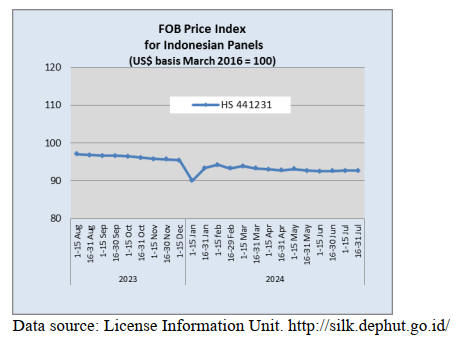
Through the eyes of industry
The latest GTI report lists the challenges identified by the
private sector in Indonesia.
See, GGSC https://www.itto-ggsc.org/static/upload/file/20240719/1721354559472477.pdf
5.
MYANMAR
A rupee-kyat trade settlement mechanism
On 21 July 2024 the Reserve Bank of India (RBI)
authorised eight Myanmar banks to operate a rupee-kyat
trade settlement mechanism aimed at simplifying trade
between the two countries by eliminating the need for
multiple currency conversions. This mechanism allows
importers and exporters from both countries to bypass the
US Dollar for transactions, enabling direct currency
exchanges between Myanmar Kyats and Indian Rupees.
Myanmar aims to reduce its reliance on US dollars for
trade due to increasing difficulties in procuring dollars
hoping that the new rupee-kyat trade settlement
mechanism will boost trade between the two countries
See: https://eng.mizzima.com/2024/07/24/12083
Thailand to monitor financial transaction with Myanmar
Thailand plans to form a task force to enhance financial
institutions' due diligence to prevent transactions that
could lead to arms purchases and human rights abuses in
Myanmar. This follows a UN report highlighting a surge
in money transferred through Thai banks for weapons used
by the Myanmar junta. The Bank of Thailand and the
Anti-Money Laundering Office will lead the initiative.
See:
https://eng.mizzima.com/2024/07/12/11667 and https://www.ban
gkokpost.com/thailand/general/2835537/thailand-to-set-up-task-
force-to-prevent-transactions-for-myanmar-arms
Small scale producers rely on income from mangrove charcoal trade
Mangrove deforestation, driven by charcoal production,
shrimp farming and urbanisation has severely impacted
local ecosystems and communities. Efforts to regulate the
industry, such as the annual production quota, have largely
failed. Small-scale producers in Myanmar have few
alternative livelihoods. In the Thai Port of Ranong migrant
workers are hired to repack and load charcoal sourced
from Tanintharyi mangrove forests despite the trade being
illegal under Myanmar’s 2018 Forest Law.
The amount of Myanmar charcoal imports by Thailand has
decreased, dropping from 104,018 tonnes in 2014 to
69,004 tonnes in 2023 though the overall trade value
remains high due to rising prices. Most charcoal is re-
exported from Thailand to countries like China, Japan,
Australia and Bahrain.
See - https://www.frontiermyanmar.net/en/mangrove-loss-in-
tanintharyi-hits-illegal-charcoal-trade-with-thailand).
Now - President Min Aung Hlaing
General Min Aung Hlaing, holding portfolios as Chief of
Commender, Chairman of State Administration Council
(SAC) and Prime Minister of the government, assumed the
new role of interim president following the Acting
President Myint Swe's medical leave.
ASEAN has excluded Myanmar's political appointees
from its high-level meetings, inviting "non-political
representatives" instead. The junta's efforts to regain
ASEAN's recognition include sending a Foreign Ministry
official to recent meetings. Despite these efforts by
ASEAN the crisis in Myanmar continues to escalate with
an estimated three million people displaced and
widespread poverty affecting half the population.
See: https://www.msn.com/en-us/news/world/myanmar-junta-
leader-assumes-presidential-powers-as-president-takes-sick-
leave-state-media-reports/ar-BB1qr4tQ?ocid=BingNewsVerp
In related news, Myanmar's military is expected to hold a
National Defense and Security Council (NDSC) meeting
to consider extending the state of emergency which is
renewed every six months. According to the constitution,
if the declaration is terminated the NDSC will hold general
elections to form a parliament within six months.
Statement on Myanmar from ASEAN Foreign Minister Meeting
The 57th ASEAN Foreign Ministers’ Meeting (AMM)
was held on 25 July 2024, in Vientiane, Lao PDR. The
Meeting was chaired by Lao PDR under the theme
“ASEAN: Enhancing Connectivity and Resilience.”
On Myanmar the statement from the meeting says “ We
reaffirmed ASEAN’s continued support for Myanmar’s
efforts to bring peace, stability, the rule of law, promote
harmony and reconciliation among the various
communities, as well as ensure sustainable and equitable
development in Rakhine State.
We emphasised the importance of and reiterated our
continued support for Myanmar’s commitment to ensuring
safety and security for all communities in Rakhine State as
effectively as possible and facilitating the voluntary return
of displaced persons in a safe, secure, and dignified
manner. We noted and encouraged the engagement and
cooperation between Myanmar and Bangladesh for the
pilot repatriation project.
We looked forward to ASEAN’s continued facilitation of
the repatriation process through the implementation of
projects as the follow up to the recommendations of the
Preliminary Needs Assessment (PNA). We also looked
forward to the Comprehensive Needs Assessment (CNA)
when conditions allow and encouraged the Secretary-
General of ASEAN to continue identifying possible areas
for ASEAN to effectively facilitate the repatriation
process”
See: https://asean.org/joint-communique-of-the-57-asean-
foreign-ministers-meeting/
and
https://www.scmp.com/news/asia/southeast-
asia/article/3272153/asean-top-diplomats-condemn-myanmar-
violence-urge-peaceful-means-settle-sea-disputes
6.
INDIA
India budget promises spending and job growth
India's Finance Minister, Nirmala Sitharaman, presented
the first full annual budget of Prime Minister Narendra
Modi's new government which took charge in June. Its
focus on the poor, women, youth and farmers was
highlighted. Sitharaman outlined plans to increase
spending, generate jobs and offer middle-class tax relief,
with extensive job creation expected over the next five
years and significant changes in tax brackets and rates.
The budget included massive allocations for infrastructure
and housing which may spur demand in the wood panel
sector.
The budget is themed on improving access to physical,
social and digital infrastructure along with workforce
skills upgradinge. The finance minister announced a flurry
of measures for boosting the infrastructure, housing and
micro and small/medium sized enterprises.
The budget allocates Rp11.1 lakh crore (approx. US$132
billion) for infrastructure with 12 industrial parks
sanctioned under the National Industrial Corridor
Development Programme. Investment-ready industrial
parks are to be developed in or near 100 cities.
See:: https://www.business-standard.com/budget/news/union-
budget-2024-here-are-the-key-highlights-from-fm-sitharaman-s-
speech-124072300664_1.html
and
https://wadeasia.us16.list-
manage.com/track/click?u=7cd7ea804c413675d899051e6&id=b
619d26205&e=dc98727776
India's path to prosperity is via growth
An article in Nikkei.com, quoting Chetan Ahya, the Chief
Asia Economist for Morgan Stanley, suggests that supply-
side reforms and private investment are the key to India's
economic future.
The return of a coalition government in India after two
terms has raised the intensity of the policy debate over
whether the country needs to enact more aggressive
redistributive policies.
Ahya’s view is that one of the key drivers for India's
growth, which Morgan Stanley forecasts to be quite
healthy at 6.5% next year, is improvement in private
investment. Policy continuity, focused on boosting
infrastructure investment and encouraging private
investments with tax incentives, is the best way to achieve
this.
See: https://asia.nikkei.com/Opinion/India-s-path-to-prosperity-
is-through-growth-not-
redistribution?utm_campaign=GL_opinion&utm_medium=email
&utm_source=NA_newsletter&utm_content=article_link&del_ty
pe=6&pub_date=20240720093000&seq_num=17&si=fe0afe7c-
532b-443e-bd57-30a8db100322
IMF raises India’s GDP forecast
The International Monetary Fund (IMF) raised its
projection for India’s gross domestic product (GDP)
growth for 2024-25 by 20 basis points to 7% amid a boost
in private consumption, especially in rural areas.
“The forecast for growth in India has been revised upward
with the change reflecting carryover from upward
revisions to growth in 2023,” the update to the IMF’s
World Economic Outlook (WEO) said. In 2025-26, the
IMF expects growth to slow to 6.5%, as it stated in its
April World Economic Outlook.. The RBI has projected
the Indian economy to grow at 7.2% in FY25.
See: https://www.business-standard.com/
Cost C&F Indian ports in US dollars, Hoppus measure
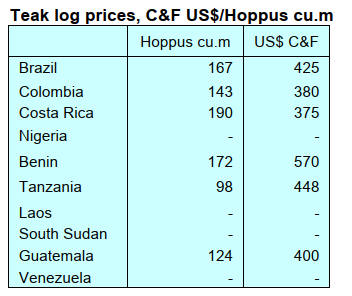
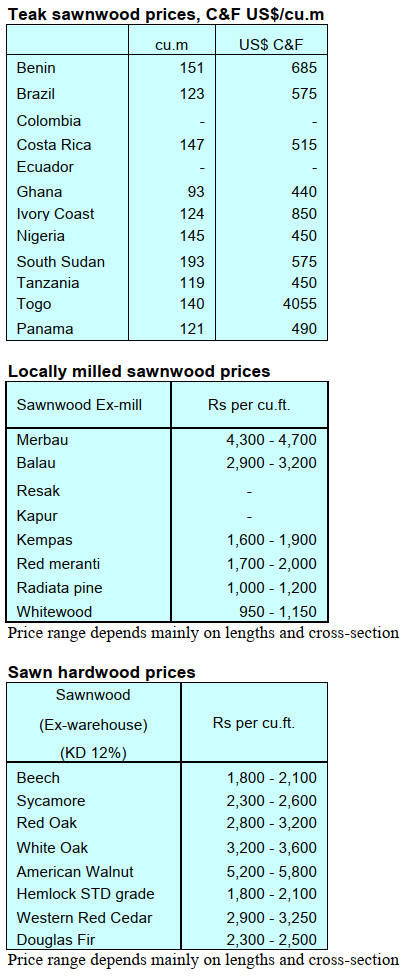
Indian plywood price increases
Plywood manufacturers in India have agreed price
increases. Indian plywood markets are witnessing a
shortfall in imports due to growing container issues and
logistical delays. The price of containers has risen, the
steepest rise since the Covid pandemic. The surge in prices
of imported plywood is also due to higher prices being
demanded for adhesives as well as sea freight.
Rising prices for imported plywood is helping improve the
competitiveness of Indian domestic manufacturers. But
domestic manufacturers have to absorb rising costs of
imported core veneer.
See: https://www.plyreporter.com/plywood/news-of-the-week
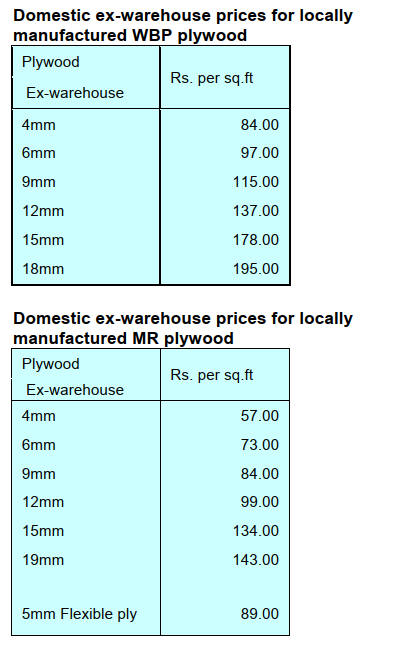
7.
VIETNAM
Vietnam wood and wood product trade
highlights
According to Vietnam Customs, wood and wood products
(W&WP) exports to the Chinese market in June 2024
reached US$214 million, up 79.2% compared to June
2023. In the first six months of 2024, W&WP export
turnover from the Chinese market was Vietnam US$1.1
billion, up 54.1% year-on-year.
In June 2024, Vietnamese exports of kitchen furniture
amounted to US$118 million, up 12.4% compared to June
2023. Over the first six months of 2024, export turnover of
kitchen furniture was US$646 million, up 28.9% over the
same period in 2023.
Vietnam's oak imports in June 2024 reached 32,400 cu.m,
worth US$18.6 million, up 1.8% in volume and 1.0% in
value compared to May 2024. Compared to June 2023,
oak imports increased by 9.0% in volume and 17.2% in
value. In the first six months of 2024, oak imports were
167,500 cu.m, worth US$96.1 million, up 23.3% in
volume and 27.1% in value over the same period in 2023.
Exports to China soaring
Vietnam’s W&WP exports to China in June 2024 were
US$214 million, up 79.2% compared to June 2023 and for
the first six months reached US$1.1 billion, up 54.1% over
the same period in 2023. Of the W&WP exported to
China, woodchips dominated in the first five months of
2024, being worth US$762.4 million, up 61.3% over the
same period in 2023 and accounting for 85.9% of the total
W&WP exports to the country.
At present, China's paper industry relies heavily on a
combination of imported and locally sourced pulp and
woodchips. The balance between these two fibre sources is
mainly influenced by fluctuating pulp prices in the global
market and costs associated with importing hardwood
chips to feed Chinese pulp and paper mills. In the past 15
years, woodchip imports into China have exceeded pulp
imports.
In 2022, woodchip imports accounted for 64% of China’s
total wood pulp and chip imports. In 2023, as the market
price of pulp fell more significantly than that of wood
chips, China increased pulp imports to 28 million tons, up
24% compared to 2022. As a result, Vietnam's woodchip
exports to the Chinese market decreased.
However, as of the first five months of 2024, Vietnam's
woodchip exports to the Chinese market regained growth
due to soaring demand. Statistics from the China Customs
Administration reveal that China’s woodchip imports in
the first five months of 2024 reached 7.5 million tons,
worth US$1.4 billion, up 35.4% in volume and 12% in
value over the same period in 2023. Of this, woodchip
imports from Vietnam amounted to five million tons,
worth US$833.7 million, up 64.9% in volume and 32.4%
in value over the same period in 2023.
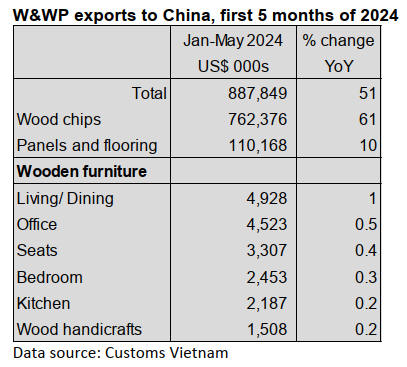
Department of Forestry (DoF) and Suntory PepsiCo
Vietnam co-operation
The DoF under the Ministry of Agriculture and Rural
Development (MARD) and Suntory PepsiCo Vietnam
have signed a memorandum of understanding (MoU) for
sustainable forest development, towards water
replenishment and carbon offset forestry investment and
development. The agreement came as part of a public-
private partnership conference in the multi-use value of
forest ecosystems. The event also marked the launch of the
National Forest Passport Initiative.
See: http://en.stockbiz.vn/News/2024/7/12/1625476/forestry-
department-and-suntory-pepsico-vietnam-co-operate-in-
sustainable-forest-development.aspx
Vietnam has over 14.86 million hectares of forests, rich
and diverse in ecosystem values. Over the years, the
forestry sector has promoted the policy of 'socializing
forestry' through various mechanisms and policies.
Under the MoU, the two sides will work together to plant
native and large timber trees, regenerate water resources,
increase carbon absorption and protect the environment,
while enhancing livelihoods for local people.
Vietnam Carbon Standard and sales of carbon credits
To achieve the goal of net zero emissions by 2050,
Vietnam has issued several policies on reducing
greenhouse gas emissions. Decree No. 06/2022/ND-CP of
the government stipulates regulations on greenhouse gas
inventory, emission reduction and development of the
domestic carbon market. However, these regulations are
not detailed, leading to difficulties in implementation.
Currently, this Decree is being revised.
The forestry sector has been undertaking emission
reduction activities and in readiness for the domestic
carbon market and emission reduction targets. Learning
from emission reduction programs and international
voluntary carbon markets, the development of the national
standard (TCVN) on forest carbon credits has been
officially approved.
The carbon standard will be considered as part of the
Vietnam Forest Certification Scheme (VFCS) to generate
benefits from forest carbon as an additional financing
source for forest owners. The carbon standard is expected
to be issued by the end of 2025.
According to the DoF, in recent years a number of
localities have received proposals from domestic and
international organizations and individuals to provide
technical services in measurement, reporting, appraisal
and verification of carbon credits for selling.
The DoF has warned that the carbon credit trade is
immature and the legal framework is incomplete and in
need of further studies and improvements. To date
Vietnam has collected US$51.5 million from the sale of
forest carbon credits
According to DoF, Vietnam, so far, has been
implementing only one forest carbon credit transfer
program, titled the North Central Region Emission
Reduction Payment Agreement (ERPA), which was signed
on October 22, 2020 between the Ministry of Agriculture
and Rural Development and the International Bank for
Reconstruction and Development of the World Bank.
See: https://vfcs.org.vn/en/news/development-of-a-national-forest-carbon-standard/
8. BRAZIL
Forest Service views concessions as the route to
SFM
and forest conservation
Brazil has announced a plan to expand selective logging
through additional forest concession areas. President Luiz
Inácio Lula da Silva plans to establish these over as much
as 310,000 square kilometres of public undesignated
Amazon rainforest.
The Brazilian Forest Service views concessions as the
route to conservation of these areas. Companies that hold
timber concessions must follow strict rules. They can log
up to six trees per hectare over a 30-year period. Species,
such as Brazil nut and mature seed-producing trees canot
be felled.
The hope is that granting permission to timber companies
to take a limited number of trees gives them a stake in
overseeing the forest. The Forest Service says studies
show that illegal deforestation in concession areas is
significantly lower than outside them.
A working group is assessing which areas should be
designated as conservation areas, Indigenous territories or
as forest concessions.
See: https://apnews.com/article/brazil-amazon-forest-protection-
logging-3afaaaf3789d3d2dc19c2d52584676a7
Measures to reduce forest product export bureaucracy
The Federation of Industries of the State of Mato Grosso
(FIEMT) met with the Ministry of Agriculture and
Livestock (MAPA) in Brasilia, in mid-July 2024. The
main topic of discussion was the request for measures to
streamline export procedures for forest and agro-industrial
products in what is one of the main tropical timber
producing states in the Amazon region. FIEMT requested
changes to federal regulations to reduce bureaucracy in
exporting products via containers that require pest control
fumigation treatment and a phytosanitary certificate.
It also pointed out that a proposed regulatory update could
reduce the time needed to issue certificates and release
containers by up to 15 days resulting in faster, cheaper
shipments. According to FIEMT, MAPA says it
recogniszes the need for change and will soon intervene to
simplify processes helping to boost industry
competitiveness.
See: https://www.sapicua.com.br/fiemt-e-mapa-discutem-
reducao-da-burocracia-na-exportacao-de-produtos-florestais-e-
agroindustriais
Public-private partnerships to support forest conservation
The Brazilian Forest Service (SFB) has signed a Technical
Cooperation Agreement with the Inter-American
Development Bank (IDB) and the National Bank for
Economic and Social Development (BNDES) to structure
public-private partnership (PPP) projects focused on the
sustainable management and restoration of environmental
assets in the Amazon.
With a value of US$1 million, the program is financed by
the Green Climate Fund (GCF) through the IDB's Amazon
Forever program (Programa Amazônia Sempre). The
programme will focus on structuring sub-national PPP
projects for forest conservation and the recovery of
degraded areas, including profiles, pre-feasibility and
feasibility studies, as well as the preparation and
structuring of bidding documents and contracts.
The 2023 legal change in the Brazilian Public Forest
Management law for sustainable production allows
payment for environmental services in forest concessions
which represent a unique opportunity to encourage private
sector participation in forest restoration projects. This
forest concession model has the potential to attract up to
R$60 billion (approximately US$12 billion) in
investments, developing a new production chain for
regeneration of degraded areas while aiming to promote
bio-business and sustainable practices in the Amazon
region.
See: https://www.yumpu.com/pt/document/read/68748303/florestal-264web
Rise in value of wood product exports
In June 2024, total Brazilian exports of wood-based
products (except pulp and paper) increased 7.4% in value
compared to June 2023, from US$291.5 million to
US$313.1 million.
Pine sawn wood exports increased 1.9% in value between
June 2023 (US$58.6 million) and June 2024 (US$59.7
million). In volume, exports remained the same at 251,000
cu.m.
Tropical sawn wood exports decreased 4.9% in volume,
from 28,700 cu.m. in June 2023 to 27,300 cu.m. in June
2024. In value, exports decreased 22.2% from US$ 14.4
million to US$ 11.2 million, over the same period.
Pine plywood exports increased 61.9% in value in June
2024 (US$79.0 million) compared to June 2023 (US$48.8
million). By volume, exports increased 51.7% over the
same period, from 148,300 cu.m. (June 2023) to 224,900
cu.m. (June 2024).
Tropical plywood exports remained the same in volume
and value in June 2023 and June 2024 at 2,900 cu.m. and
US$1.8 million.
Wood furniture export value decreased 2% from US$45.4
million in June 2023 to US$44.5 million in June 2024.
Wood panel exports higher in the first quarter
The Brazilian forestry sector ended the first quarter of
2024 with a positive balance of US$3.2 billion, an increase
of 1.5% on the same period in 2023. IBÁ (the Brazilian
Tree Industry) highlighted wood panel exports as the key
factor in the rise.
The wood-based panel sector showed a robust
performance in the first quarter of 2024, with exports
growing 57% over the same period in 2023, reaching
369,000 cu.m. On the domestic market, sales rose by
10.4%, totalling 1.8 million cu.m.
China remains the main market for Brazilian forest
products. Exports to Europe, the second largest market,
increased 1.8% to US$ 814.1 million in the first quarter of
2024, while exports to North America increased 6.1%,
reaching US$810.7 million.
An additional highlight was growth in Brazilian exports to
Africa, up 17.1% in the first quarter of 2024, to US$ 59
million.
IBÁ said the Brazilian forest plantation sector is a
significant pillar of Brazil’s economy, describing it as a
crucial supplier to the world's main economies, and
contributing 4.4% of the country's total exports in the first
quarter of 2024.
See: https://www-portaldoagronegocio-com-
br.translate.goog/florestal/mercado-florestal/noticias/setor-
florestal-brasileiro-registra-alta-nas-exportacoes-de-paineis-de-
madeira-no-primeiro-
trimestre?_x_tr_sl=pt&_x_tr_tl=en&_x_tr_hl=en&_x_tr_pto=sc
Concerns over Brazilian nursery capacity
The Brazil Climate, Forest and Agriculture Coalition
points out that the country will need to produce 5.4 billion
native tree seedlings by 2030 to reach the target of
reforesting 12 million hectares and to fulfil its
commitment under the Paris Agreement to reduce carbon
emissions.
However, there are still challenges for the country to
achieve this level of forest regeneration. Without specific
lines of credit and with few targeted public policies, the
market for native tree seedling nurseries is likely to remain
at 300 million seedlings a year, which is insufficient for
the country to meet its global commitment.
See: https://www-madeiratotal-com-
br.translate.goog/dificuldades-dos-viveiros-ameacam-
compromisso-do-brasil-no-acordo-de-
paris/?_x_tr_sl=pt&_x_tr_tl=en&_x_tr_hl=en&_x_tr_pto=sc
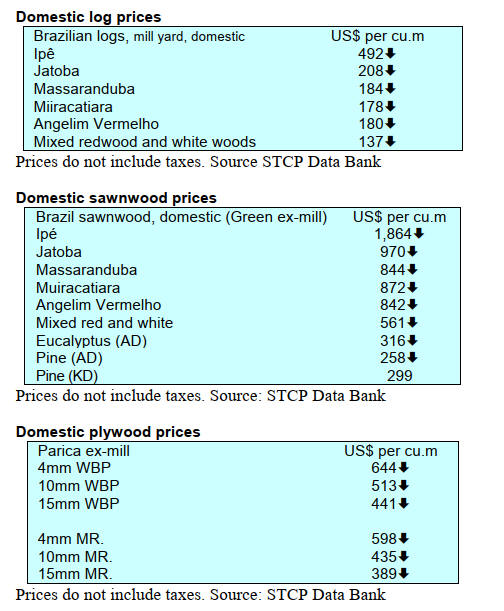
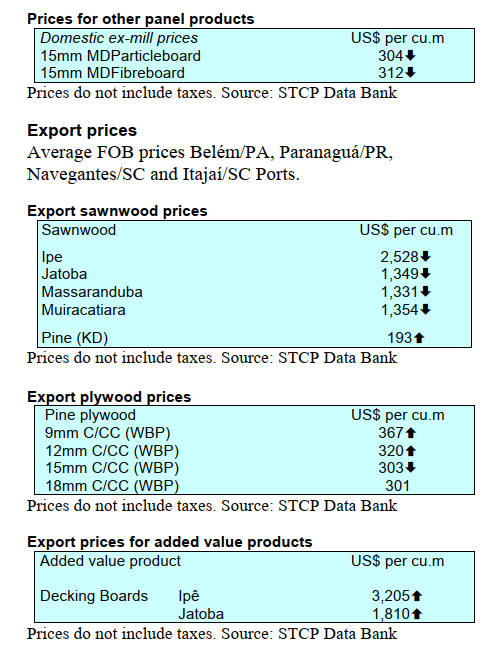
Through the eyes of industry
The latest GTI report lists the challenges identified by the private sector
in Brazil.
See, GGSC https://www.itto-ggsc.org/static/upload/file/20240719/1721354559472477.pdf
9. PERU
Peruvian furniture exports up in the first four
months of 2024
Exports of furniture and components for the period
January to April 2024 amounted to US$1.58 million, an
increase of 38.6% compared to the same period in 2023,
when they reached US$ 1.14 million.
The main export market for veneer and plywood during
the January to April 2024 period was the United States,
which represented 64.5% of total export value. Chile
followed with 7% of export value and in third place was
Italy with 6%.
Source: https://www-adexperu-org-pe
New FSC Forest Management Standard for Peru
FSC announced the official publication of the new FSC
Forest Management Standard for Peru which covers all
categories of management units in natural forests and
plantations, including small and low-intensity
management forests as well as non-timber forest products
(NTFP).
This new Standard, effective from October 2024, not only
focuses on productive forest management, but also covers
conservation and restoration management of forests.
The English version of the FSC Forest Management
Standard for Peru is available for download in the FSC
Documentation Centre.
See: https://notifix.info/en/news-en/markets/44944-new-fsc-
forest-management-standard-for-peru
Peru applies to host the XVI World Forestry Congress
in 2027
In the framework of the Committee on Forestry (COFO
27), held at the Food and Agriculture Organization of the
United Nations (FAO) headquarters in Rome (Italy), the
Ministry of Agrarian Development and Irrigation
announced that Peru has applied to host the XVI World
Forestry Congress to be held in 2027.
The World Forestry Congress is held approximately once
every six years. The forum allows for the exchange of
opinions and experiences on issues related to forests and
forestry that result in recommendations applicable at
national, regional and global levels. Host countries receive
technical support from FAO.
See: https://www.gob.pe/institucion/serfor/noticias/993981-
peru-postulo-para-ser-sede-del-xvi-congreso-forestal-mundial-
2027
Government to co-finance forest plantations
The Ministry of Agrarian Development and Irrigation,
through the National Forest and Wildlife Service
(SERFOR) and its Sustainable Productive Forests Program
(BPS), will co-finance US$3.93 million in up to 20 forest
plantation projects with communities, associations of
producers and MSMEs within the Departments of Junín,
Áncash, and Huánuco.
The finance should allow the establishment of 2,000
hectares of forest plantations which will contribute to
improving community livelihoods.
The co-financing forms part of the Forest Incentive Plan
(PIF) of the BPS programme, launched in April 2024
seeking to promote forest plantations for commercial
purposes with the objective of reducing pressure on
natural forests, increasing timber forest production in the
country and contributing to the economy and well-being of
the population.
See: https://www.gob.pe/institucion/serfor/noticias/989711-
gobierno-cofinanciara-mas-de-14-millones-de-soles-en-
proyectos-de-plantaciones-forestales-de-productores-durante-
este-ano

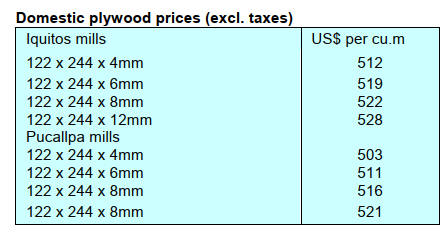
|